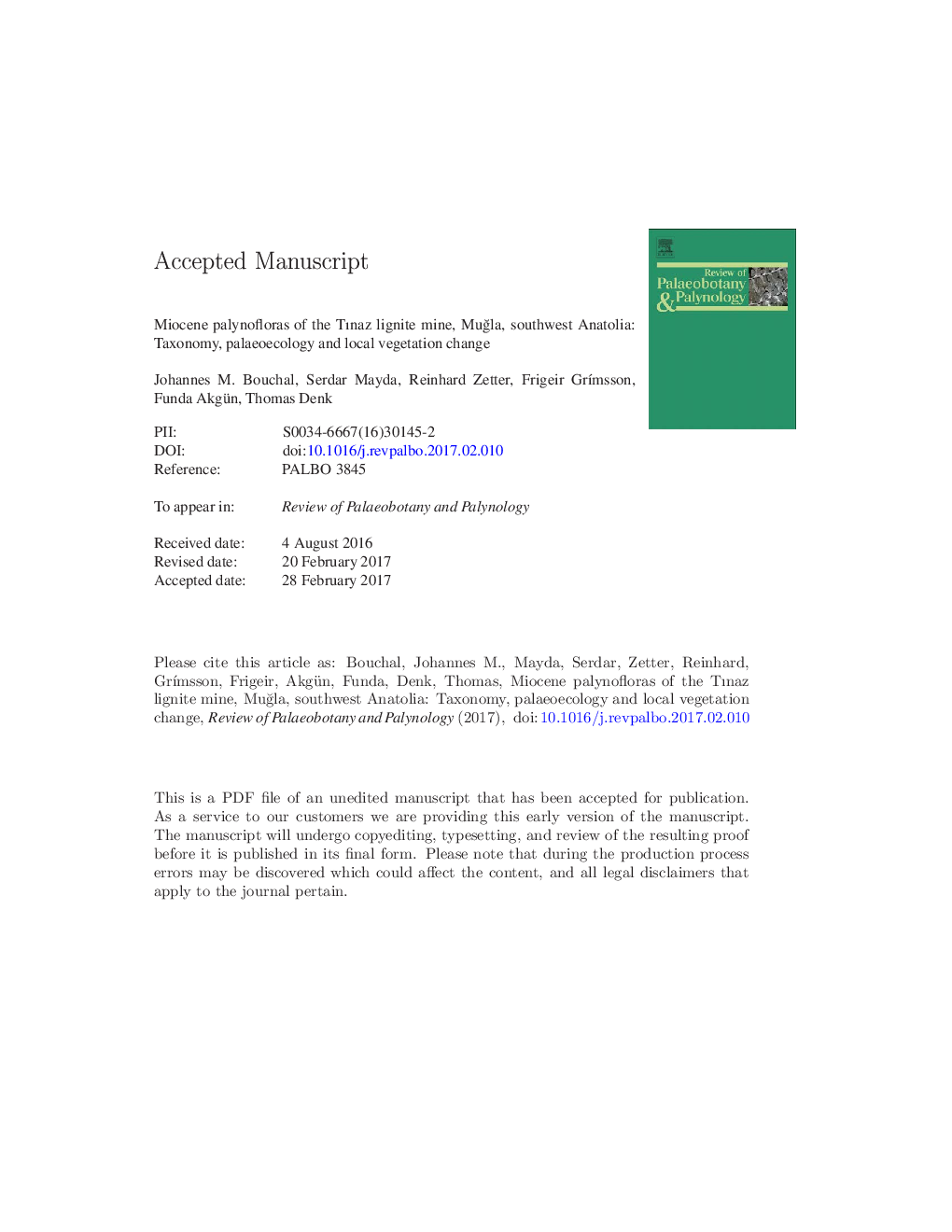| کد مقاله | کد نشریه | سال انتشار | مقاله انگلیسی | نسخه تمام متن |
|---|---|---|---|---|
| 5788347 | 1642454 | 2017 | 131 صفحه PDF | دانلود رایگان |
عنوان انگلیسی مقاله ISI
Miocene palynofloras of the Tınaz lignite mine, MuÄla, southwest Anatolia: Taxonomy, palaeoecology and local vegetation change
دانلود مقاله + سفارش ترجمه
دانلود مقاله ISI انگلیسی
رایگان برای ایرانیان
کلمات کلیدی
موضوعات مرتبط
مهندسی و علوم پایه
علوم زمین و سیارات
فسیل شناسی
پیش نمایش صفحه اول مقاله

چکیده انگلیسی
Middle Miocene deposits belonging to the Eskihisar Formation exposed at the Tınaz lignite mine, YataÄan Basin, MuÄla, southwestern Turkey, were investigated palynologically. Nine spores, aplanospores/zygospores and cysts of fungi and algae, seven moss and fern spores, 12 gymnosperm pollen types, and more than 80 angiosperm pollen taxa were recovered from the Tınaz lignite mine section. Three informal pollen zones were recognized: pollen zone 1 corresponds to the main lignite seam and reflects changes from fluviatile to lacustrine depositional settings; pollen zones 2 and 3 and a transitional zone 2-3 reflect different stages of lake development and a shift from forested (pollen zones 1 and 2) to possibly more open (transitional zone, zone 3) local vegetation. Interpreting changes in regional vegetation from pollen zones 1 to 3 is not straightforward because changes in the pollen spectra may be affected by changing contributions of airborne and water-transported pollen and spores to the depositional site. In addition, changes of the water table may have promoted temporary dominance of herbaceous plants (Amaranthaceae, Nitraria). Palaeobiogeographic relationships of the palynofloras are generally northern hemispheric, with many northern temperate tree taxa having modern disjunctions between East Asia and North America (Tsuga, Carya), East Asia and western Eurasia (Zelkova), East Asia, North America and western Eurasia (Liquidambar), or restricted to East Asia (Cathaya, Eucommia) or North America (Decodon). A few taxa belong to extinct lineages that have complex biogeographic patterns (Engelhardioideae, Cedrelospermum). The presence of Picrasma (Simaroubaceae) in the lower lignite layers of pollen zone 1 is remarkable, as the botanical affinities of the enigmatic flower Chaneya, present in lower to middle Miocene deposits of Turkey and Central Europe, have recently been shown to be with Picrasma.
ناشر
Database: Elsevier - ScienceDirect (ساینس دایرکت)
Journal: Review of Palaeobotany and Palynology - Volume 243, August 2017, Pages 1-36
Journal: Review of Palaeobotany and Palynology - Volume 243, August 2017, Pages 1-36
نویسندگان
Johannes M. Bouchal, Serdar Mayda, Reinhard Zetter, Friðgeir GrÃmsson, Funda Akgün, Thomas Denk,